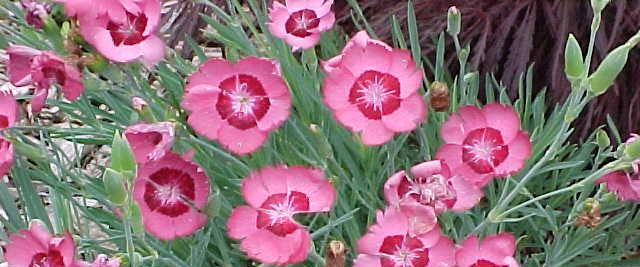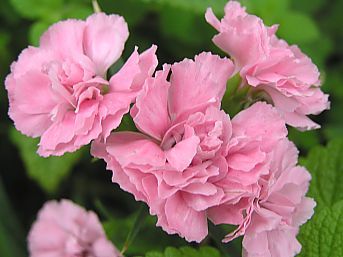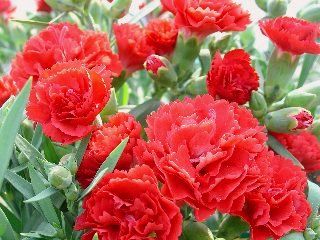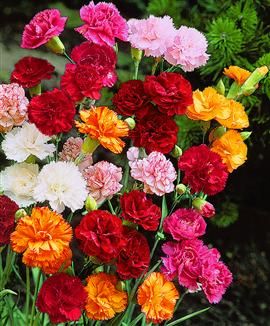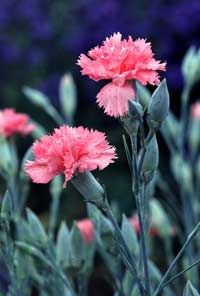Dianthus Caryophyllus
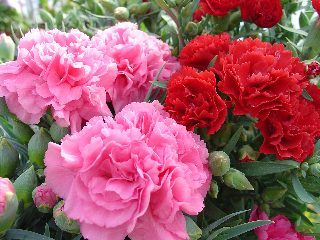
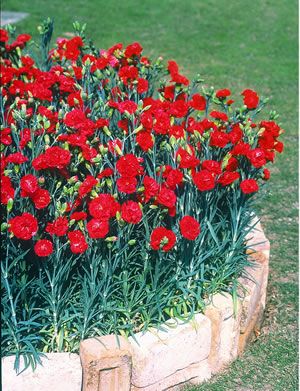
Common name: Carnation, Divine flower, Clove pink, Gilly Flower
Family: Caryophyllaceae
Height: 18-24 in. (45-60 cm)
Spacing: 15-18 in. (38-45 cm)
Sun Exposure: Full Sun
Soil pH requirements: 6.6 to 7.5 (neutral), 7.6 to 7.8 (mildly alkaline)
Water: Average Water Needs; Water regularly; do not overwater
Bloom Time: Late Spring/Early Summer, Mid Summer
Foliage: Evergreen, Blue-Green
Description
Dianthus are a genus of evergreen or semi-evergreen, mainly summer flowering group of annuals, biennials, and perennials. Carnations and Pinks have narrow lanceolate, silvery or grey-green leaves scattered along flower stems, with leaves that may coil outwards on Carnations. The plants have fragrant, semi-double rosy, purple or white flowers. There are many hybrid varieties in a variety of colours and sizes with no fragrance. They bloom mainly during cool times of the year, especially early winter. They are great plants to grow in gardens and can be used as cut-flowers. If properly treated, carnations will last up to a month.
Native of the Eurasia, Carnations; the most popular garden plant is one among some 300 species of annual, biennial and perennial herbs in the genus Dianthus. There are hundreds of more hybrid varieties. Dianthus in Greek means 'Flower of Zeus' or Divine flower.
Carnations will grow from 2 - 3 feet high, most garden varieties grow 10 to 20 inches tall.
|
|
|
Care and cultivation
Amongst the prized blooms that have both commercial as well as ornamental value is the elegant carnation. Gardeners are usually not fully aware of the techniques of growing carnations. Carnations are suitable for bed planting, borders, rock gardens or even for pots. These are available in many hues and colors like red, crimson, orange, lavender, lemon, pink, cherry, white, cream etc.
Carnations require fertile, slightly alkaline, neutral, well-drained soil and 4-5 hours of full sun each day. They should be planted 12-18 inches apart.
Carnations should be kept moist. Avoid over-watering as it may tend to turn the foliage yellow. For continued blooming feed lightly every 6 to 8 weeks with an all-purpose (10-10-10) liquid fertilizer. Spent flowers should be removed promptly to promote continued blooming.
Those who grow carnations know how important it is to carry out the pinching, stopping and disbudding. In case of the spray-type free flowering carnations, the plant is pinched at the six-node (the swollen part where the leaf pair emerges) stage. At that time it is about six inches tall. This type of removal or cutting of the main stem encourages emergence of lateral stems that are again pinched at the terminal. The more the number of terminals, the more the number of blooms one gets. These operations should be done right in the beginning as repeated pinching may delay flowering. The plants should also be staked in the beginning to get straight growth. In case fewer blooms are required, the plant is pinched once when it is about six inches high, and then later when the lateral shoots are four to six inches long, which is about four weeks after the first pinching. Once planted in a flower bed the carnation should be irrigated every five to seven days. In a pot, the frequency should be three to five days.
The usual living-room conditions as to moisture and heat are not such as the carnation demands, and care must be taken to overcome the dryness by spraying the foliage and setting the plant in a position not exposed to the direct heat of a stove or the sun.
|
|
|
Propagation Methods
1. Seeds. To colect them, allow seedheads to dry on plants; remove and collect seeds. Properly cleaned, seed can be successfully stored. Can be sowed indoors before last frost, 1/8 inch deep in a well drained mix in spring or early summer. Make sure the compost is moist but not wet. Mist spray occasionally and keep it moist. The seeds will germinate in 2 to 3 weeks. Transplant in pots or on the ground when large enough to handle and the plants will bloom in 6 - 9 months or a year.
2. Cuttings can be taken off any carnation, but the best shoot come from cuttings off a year-old plant after it has bloomed. In fact, the flower stem is often the only place where a carnation will form a stalk long enough to take a cutting from. It is best to take carnation cuttings in early Fall. They will root at the swollen node hidden beneath each leaf. Cut at an angle just below a node, and trim off the top, leaving 1 node for roots at the bottom and one at the top for the growth to come out of. Poke into well-drained soil in pots or in a seedling tray.
3. Layering is the easiest way to propagate carnations and the plant will do this themselves once mature. Observing a mature clump of carnations, seek out sturdy stems pointing away from the centre of the clump. If you look at the bottoms of these stems they will often be rooted, and if they are not yet, you can promote rooting by bending them down to touch the soil. Keep them pinned down with a rock, a stick, or whatever else. Cut off any flowers that are growing on that particular stem. Within a few weeks you will see your new plant rooting. Once the roots seem 4 to 5 inches long, cut this new plant away from the mother plant and repot in well-drained soil.
4. They can also be propagated by division. Dig up the whole non productive clump of an old plant. Gently and carefully separate the plant segments with your hands or gardening fork. Replant each new division in a well drained mix and keep it moist.
Articole asemănătoare
-
Garoafa, floarea celor nascuti in ianuarie
Toti cunoastem garoafele pentru ca fiecare am daruit candva un buchet de garoafe, insa putini stim ca ea este prin excelenta floarea persoanelor nascute in luna ianuarie.
-
Parcul Natural Defileul Muresului Superior
Parcul Natural Defileul Muresului Superior este o arie protejata situata in regiunea central-nordica a Romaniei, in raza comunelor Deda, Rastolita, Lunca Bradului si Stanceni.
-
Activitatile din sera in luna Ianuarie
Una dintre cele mai mari satisfactii oferite de orice sera este ca pana si iarna, plantele sunt colorate si pline de viata, in timp ce afara majoritatea speciilor dorm adanc sub stratul de zapada.
-
Garofitele cu miresme deosebite
Par a fi fragile precum portelanul si delicate precum dantela, insa in realitate garofitele sunt extrem de rezistente si deloc pretentioase
-
Parcul National Pindos, Grecia
Parcul National Pindos este situat in partea de nord-vest a Greciei intr-o regiune izolata din Muntii Pindului.
